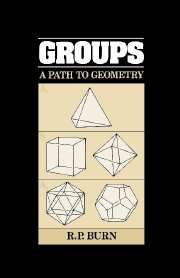Book contents
- Frontmatter
- Contents
- Preface
- Acknowledgements
- 1 Functions
- 2 Permutations of a finite set
- 3 Groups of permutations of ℝ and ℂ
- 4 The Möbius group
- 5 The regular solids
- 6 Abstract groups
- 7 Inversions of the Möbius plane and stereographic projection
- 8 Equivalence relations
- 9 Cosets
- 10 Direct product
- 11 Fields and vector spaces
- 12 Linear transformations
- 13 The general linear group GL(2, F)
- 14 The vector space V3(F)
- 15 Eigenvectors and eigenvalues
- 16 Homomorphisms
- 17 Conjugacy
- 18 Linear fractional groups
- 19 Quaternions and rotations
- 20 Affine groups
- 21 Orthogonal groups
- 22 Discrete groups fixing a line
- 23 Wallpaper groups
- Bibliography
- Index
11 - Fields and vector spaces
Published online by Cambridge University Press: 05 June 2012
- Frontmatter
- Contents
- Preface
- Acknowledgements
- 1 Functions
- 2 Permutations of a finite set
- 3 Groups of permutations of ℝ and ℂ
- 4 The Möbius group
- 5 The regular solids
- 6 Abstract groups
- 7 Inversions of the Möbius plane and stereographic projection
- 8 Equivalence relations
- 9 Cosets
- 10 Direct product
- 11 Fields and vector spaces
- 12 Linear transformations
- 13 The general linear group GL(2, F)
- 14 The vector space V3(F)
- 15 Eigenvectors and eigenvalues
- 16 Homomorphisms
- 17 Conjugacy
- 18 Linear fractional groups
- 19 Quaternions and rotations
- 20 Affine groups
- 21 Orthogonal groups
- 22 Discrete groups fixing a line
- 23 Wallpaper groups
- Bibliography
- Index
Summary
The word ‘field’ describes abstractly an algebraic structure in which the operations +, -, × and ÷ may be performed in much the same way as they are performed with the rational numbers. When copies of a field F are used to make cartesian products such as F × F or F × F × F such cartesian products are called vector spaces when furnished with a suitable addition of elements and multiplication by a scalar (i.e. a field element).
Concurrent reading: Birkhoff and MacLane, chapter 2, section 1 and chapter 7, sections 1–4.
Fields
If in a group (G, ·) xy = yx for any two elements x, y ∈ G, then the group G is said to be commutative, or abelian.
1 The rational numbers ℚ, the real numbers ℝ and the complex numbers ℂ each form an abelian group under addition, and, with the deletion of zero, an abelian group under multiplication. These two properties, together with the distributive laws a · (b + c) = a · b + a · c and (a + b) · c = a · c + b · c make (ℚ, +, ·), (ℝ, +, ·) and (ℚ, +, ·) into fields, why do the integers (ℤ, +, ·) not form a field?
2 […]
Information
- Type
- Chapter
- Information
- GroupsA Path to Geometry, pp. 105 - 113Publisher: Cambridge University PressPrint publication year: 1985
